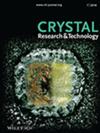Theoretical Study on the Effect of Solvent Behavior on Ammonium Dinitramide (ADN)/1,4,7,10,13,16‐Hexaoxacyclooctadecane (18‐Crown‐6) Cocrystal Growth Morphology at Different Temperatures
IF 1.9
4区 材料科学
Q3 CRYSTALLOGRAPHY
引用次数: 9
Abstract
The cocrystal of ammonium dinitramide (ADN)/1,4,7,10,13,16‐hexaoxacyclooctadecane (18‐Crown‐6) has effectively reduced the hygroscopicity of ADN. In order to understand the effect of solvent on the crystal growth, the interfacial models of ADN/18‐Crown‐6–ethanol are built and simulated by the molecular dynamics (MD) method at different temperatures (293–323 K, 10 K intervals). The energy, mass density, radial distribution function, and diffusion capacity of solvent are analyzed. The modified attachment energy (MAE) model is employed to study the solvent effect on cocrystal morphology. Results of MD simulation show that ADN/18‐Crown‐6 cocrystal has four important growth surfaces in vacuum, i.e., (2 0 0), (0 0 2), (1 1 0), and (2 0 −2). The binding energy of cocrystal and the absorbed energy of cocrystal–solvent are larger at 293 K than other temperatures. Hydrogen bonding interactions are formed between ADN/18‐Crown‐6 and solvent. More ethanol molecules adsorb on the crystal surface at lower temperatures, and hence the interaction between cocrystal and solvent is stronger. The morphology of ADN/18‐Crown‐6 cocrystal is different at various temperatures. The predicted morphology at 303 K is consistent with experimental shape. Moreover, cocrystal morphology at 293 K is a sphere‐like shape, which may reduce the hygroscopicity of ADN/18‐Crown‐6 cocrystal.不同温度下溶剂行为对二酰胺铵(ADN)/1,4,7,10,13,16‐六氧环十六烷(18‐Crown‐6)共晶生长形貌影响的理论研究
二酰胺铵(ADN)/1,4,7,10,13,16‐六氧环十六烷(18‐Crown‐6)的共晶有效降低了ADN的吸湿性。为了了解溶剂对ADN/18‐Crown‐6 -乙醇晶体生长的影响,建立了ADN/18‐Crown‐6 -乙醇在不同温度(293 ~ 323 K, 10 K区间)下的界面模型,并采用分子动力学(MD)方法进行了模拟。分析了溶剂的能量、质量密度、径向分布函数和扩散能力。采用改进的附着能(MAE)模型研究了溶剂对共晶形貌的影响。MD模拟结果表明,ADN/18‐Crown‐6共晶在真空中具有(2 0 0)、(0 0 2)、(1 0 0)和(2 0−2)四个重要的生长面。在293 K温度下,共晶的结合能和共晶-溶剂的吸收能均大于其他温度。ADN/18‐Crown‐6与溶剂之间形成氢键相互作用。在较低的温度下,更多的乙醇分子吸附在晶体表面,因此共晶与溶剂之间的相互作用更强。ADN/18 - Crown - 6共晶在不同温度下的形貌不同。在303 K时的预测形貌与实验形貌一致。此外,共晶在293 K时呈球形,这可能会降低ADN/18‐Crown‐6共晶的吸湿性。
本文章由计算机程序翻译,如有差异,请以英文原文为准。
求助全文
约1分钟内获得全文
求助全文
来源期刊
自引率
6.70%
发文量
121
审稿时长
1.9 months
期刊介绍:
The journal Crystal Research and Technology is a pure online Journal (since 2012).
Crystal Research and Technology is an international journal examining all aspects of research within experimental, industrial, and theoretical crystallography. The journal covers the relevant aspects of
-crystal growth techniques and phenomena (including bulk growth, thin films)
-modern crystalline materials (e.g. smart materials, nanocrystals, quasicrystals, liquid crystals)
-industrial crystallisation
-application of crystals in materials science, electronics, data storage, and optics
-experimental, simulation and theoretical studies of the structural properties of crystals
-crystallographic computing

 求助内容:
求助内容: 应助结果提醒方式:
应助结果提醒方式:


